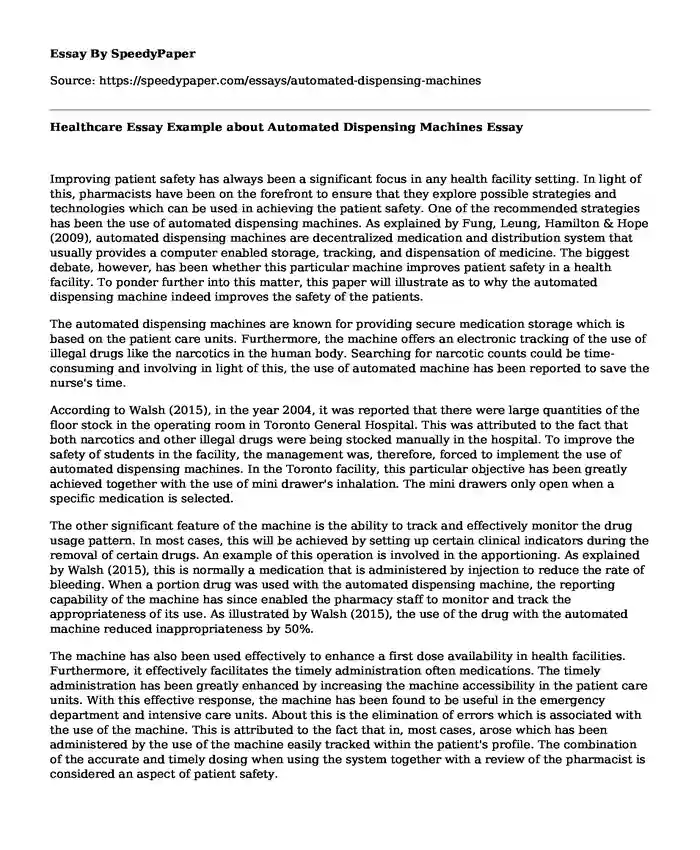
| Type of paper: | Research paper |
| Categories: | Pharmacology Healthcare |
| Pages: | 3 |
| Wordcount: | 643 words |
Improving patient safety has always been a significant focus in any health facility setting. In light of this, pharmacists have been on the forefront to ensure that they explore possible strategies and technologies which can be used in achieving the patient safety. One of the recommended strategies has been the use of automated dispensing machines. As explained by Fung, Leung, Hamilton & Hope (2009), automated dispensing machines are decentralized medication and distribution system that usually provides a computer enabled storage, tracking, and dispensation of medicine. The biggest debate, however, has been whether this particular machine improves patient safety in a health facility. To ponder further into this matter, this paper will illustrate as to why the automated dispensing machine indeed improves the safety of the patients.
The automated dispensing machines are known for providing secure medication storage which is based on the patient care units. Furthermore, the machine offers an electronic tracking of the use of illegal drugs like the narcotics in the human body. Searching for narcotic counts could be time-consuming and involving in light of this, the use of automated machine has been reported to save the nurse's time.
According to Walsh (2015), in the year 2004, it was reported that there were large quantities of the floor stock in the operating room in Toronto General Hospital. This was attributed to the fact that both narcotics and other illegal drugs were being stocked manually in the hospital. To improve the safety of students in the facility, the management was, therefore, forced to implement the use of automated dispensing machines. In the Toronto facility, this particular objective has been greatly achieved together with the use of mini drawer's inhalation. The mini drawers only open when a specific medication is selected.
The other significant feature of the machine is the ability to track and effectively monitor the drug usage pattern. In most cases, this will be achieved by setting up certain clinical indicators during the removal of certain drugs. An example of this operation is involved in the apportioning. As explained by Walsh (2015), this is normally a medication that is administered by injection to reduce the rate of bleeding. When a portion drug was used with the automated dispensing machine, the reporting capability of the machine has since enabled the pharmacy staff to monitor and track the appropriateness of its use. As illustrated by Walsh (2015), the use of the drug with the automated machine reduced inappropriateness by 50%.
The machine has also been used effectively to enhance a first dose availability in health facilities. Furthermore, it effectively facilitates the timely administration often medications. The timely administration has been greatly enhanced by increasing the machine accessibility in the patient care units. With this effective response, the machine has been found to be useful in the emergency department and intensive care units. About this is the elimination of errors which is associated with the use of the machine. This is attributed to the fact that in, most cases, arose which has been administered by the use of the machine easily tracked within the patient's profile. The combination of the accurate and timely dosing when using the system together with a review of the pharmacist is considered an aspect of patient safety.
In conclusion, in this age of technological advances, existing automated dispensing machines have significantly met the requirements for an optimum medication distribution system. As such, the consistent use of automated dispensing machines can be considered as a step towards greater patient safety.
Reference
Fung, E. Y., Leung, B., Hamilton, D., & Hope, J. (2009). Do automated dispensing machines improve patient safety?. The Canadian journal of hospital pharmacy, 62(6).
Paydar, A., Kim, S., Richardson, C., Foot, J., Amini, M., Morita, S., ... & Chai, A. (2016). U.S. Patent No. 9,355,220. Washington, DC: U.S. Patent and Trademark Office.
Walsh, M. H. (2015). Automated Medication Dispensing Cabinet and Medication Errors (Doctoral dissertation, Walden University).
Cite this page
Healthcare Essay Example about Automated Dispensing Machines. (2022, Apr 21). Retrieved from https://speedypaper.com/essays/automated-dispensing-machines
Request Removal
If you are the original author of this essay and no longer wish to have it published on the SpeedyPaper website, please click below to request its removal:
- Essay Sample: Public Internet for Neighbourhood Communities
- Education Essay Example - Application of Curriculum Phases
- Free Essay with a Reflection of the Writing Course Experience
- Essay Sample on The Movie Review of Undertow (Contracorriente)
- Essay Sample: How Effects of Automation May Help or Hurt Your Future Job Prospects
- Essay Sample on Celebrity Credibility
- Tariffs or Not for the US? Paper Example
Popular categories




